Critical Success Factors in Construction Waste Management: A Review
VerifiedAdded on 2022/10/10
|14
|4034
|444
Literature Review
AI Summary
This literature review examines the critical success factors (CSFs) of construction waste management (CWM), with a focus on the Australian construction industry. The review synthesizes findings from various studies, including those conducted in China and Malaysia, highlighting the importance of factors such as WM regulations, design modifications, and economic incentives. The review covers studies that explore strategies for waste reduction, including design for deconstruction, team building, and sustainable practices. The research also emphasizes the significance of governmental supervision, stakeholder awareness, and cultural shifts towards waste reduction. The review also considers the impact of natural disasters, technological innovations, and management issues in C&D recycling plants. The student's literature review aims to provide a comprehensive overview of the CSFs in CWM to identify and develop integrated WM systems.
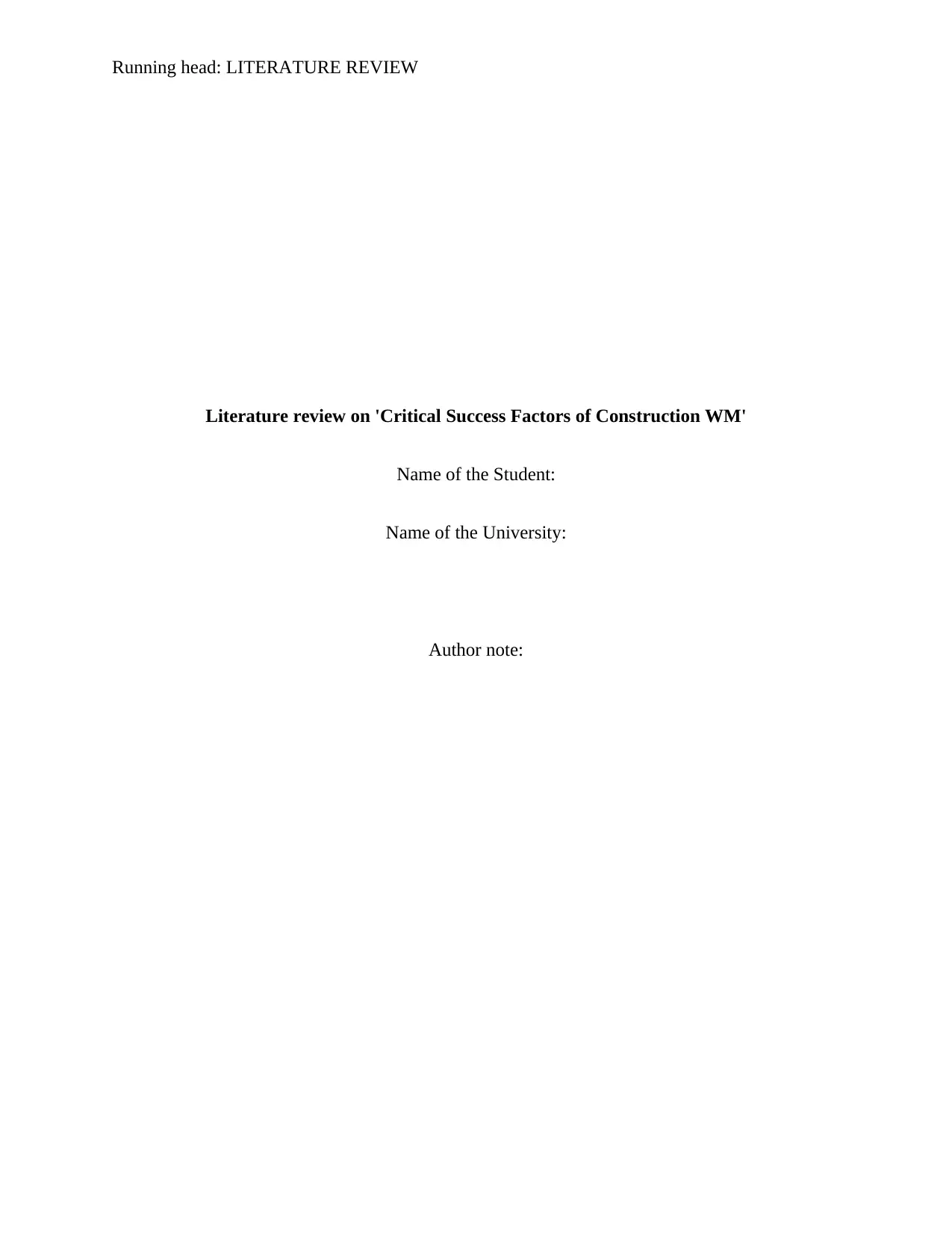
Running head: LITERATURE REVIEW
Literature review on 'Critical Success Factors of Construction WM'
Name of the Student:
Name of the University:
Author note:
Literature review on 'Critical Success Factors of Construction WM'
Name of the Student:
Name of the University:
Author note:
Paraphrase This Document
Need a fresh take? Get an instant paraphrase of this document with our AI Paraphraser
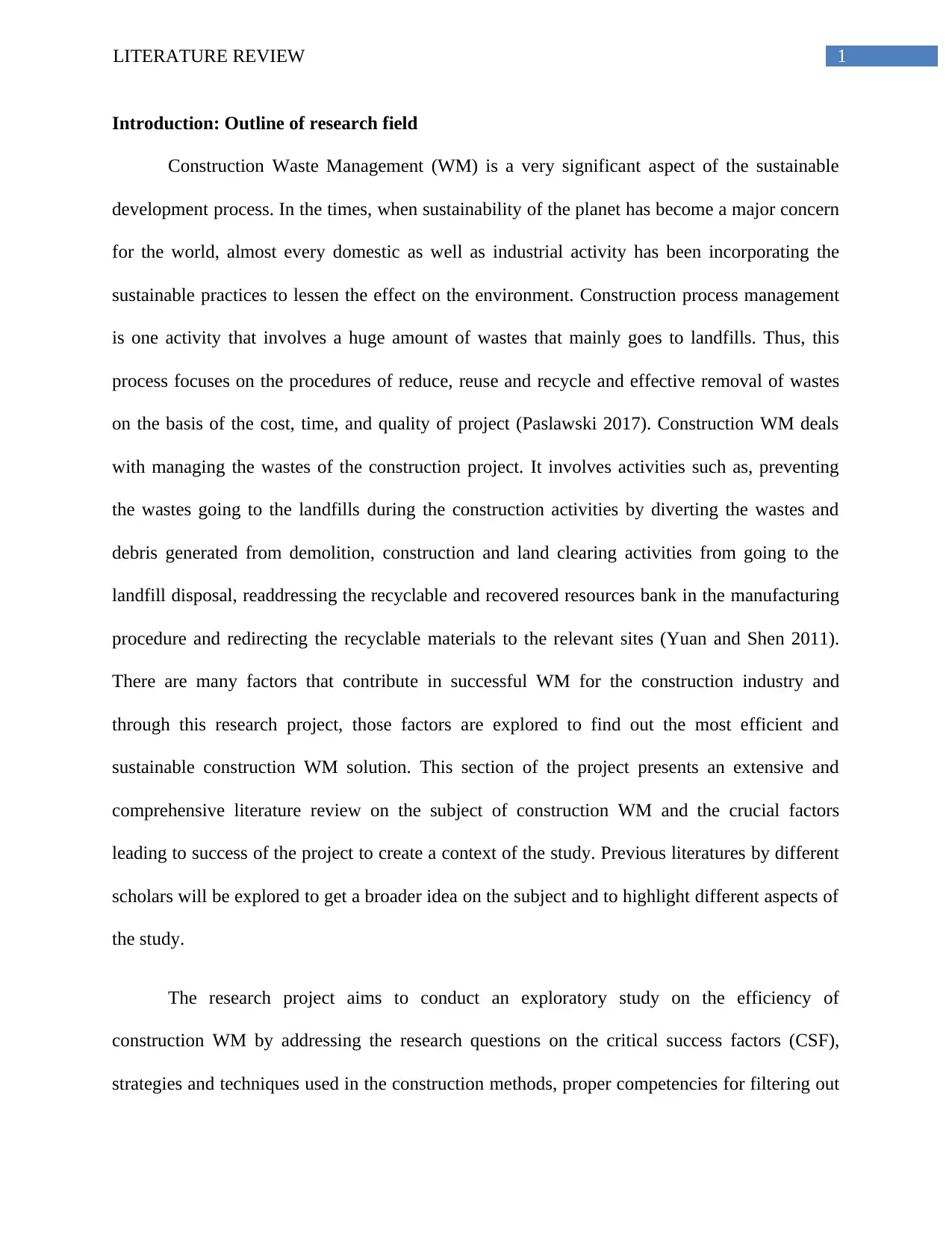
1LITERATURE REVIEW
Introduction: Outline of research field
Construction Waste Management (WM) is a very significant aspect of the sustainable
development process. In the times, when sustainability of the planet has become a major concern
for the world, almost every domestic as well as industrial activity has been incorporating the
sustainable practices to lessen the effect on the environment. Construction process management
is one activity that involves a huge amount of wastes that mainly goes to landfills. Thus, this
process focuses on the procedures of reduce, reuse and recycle and effective removal of wastes
on the basis of the cost, time, and quality of project (Paslawski 2017). Construction WM deals
with managing the wastes of the construction project. It involves activities such as, preventing
the wastes going to the landfills during the construction activities by diverting the wastes and
debris generated from demolition, construction and land clearing activities from going to the
landfill disposal, readdressing the recyclable and recovered resources bank in the manufacturing
procedure and redirecting the recyclable materials to the relevant sites (Yuan and Shen 2011).
There are many factors that contribute in successful WM for the construction industry and
through this research project, those factors are explored to find out the most efficient and
sustainable construction WM solution. This section of the project presents an extensive and
comprehensive literature review on the subject of construction WM and the crucial factors
leading to success of the project to create a context of the study. Previous literatures by different
scholars will be explored to get a broader idea on the subject and to highlight different aspects of
the study.
The research project aims to conduct an exploratory study on the efficiency of
construction WM by addressing the research questions on the critical success factors (CSF),
strategies and techniques used in the construction methods, proper competencies for filtering out
Introduction: Outline of research field
Construction Waste Management (WM) is a very significant aspect of the sustainable
development process. In the times, when sustainability of the planet has become a major concern
for the world, almost every domestic as well as industrial activity has been incorporating the
sustainable practices to lessen the effect on the environment. Construction process management
is one activity that involves a huge amount of wastes that mainly goes to landfills. Thus, this
process focuses on the procedures of reduce, reuse and recycle and effective removal of wastes
on the basis of the cost, time, and quality of project (Paslawski 2017). Construction WM deals
with managing the wastes of the construction project. It involves activities such as, preventing
the wastes going to the landfills during the construction activities by diverting the wastes and
debris generated from demolition, construction and land clearing activities from going to the
landfill disposal, readdressing the recyclable and recovered resources bank in the manufacturing
procedure and redirecting the recyclable materials to the relevant sites (Yuan and Shen 2011).
There are many factors that contribute in successful WM for the construction industry and
through this research project, those factors are explored to find out the most efficient and
sustainable construction WM solution. This section of the project presents an extensive and
comprehensive literature review on the subject of construction WM and the crucial factors
leading to success of the project to create a context of the study. Previous literatures by different
scholars will be explored to get a broader idea on the subject and to highlight different aspects of
the study.
The research project aims to conduct an exploratory study on the efficiency of
construction WM by addressing the research questions on the critical success factors (CSF),
strategies and techniques used in the construction methods, proper competencies for filtering out
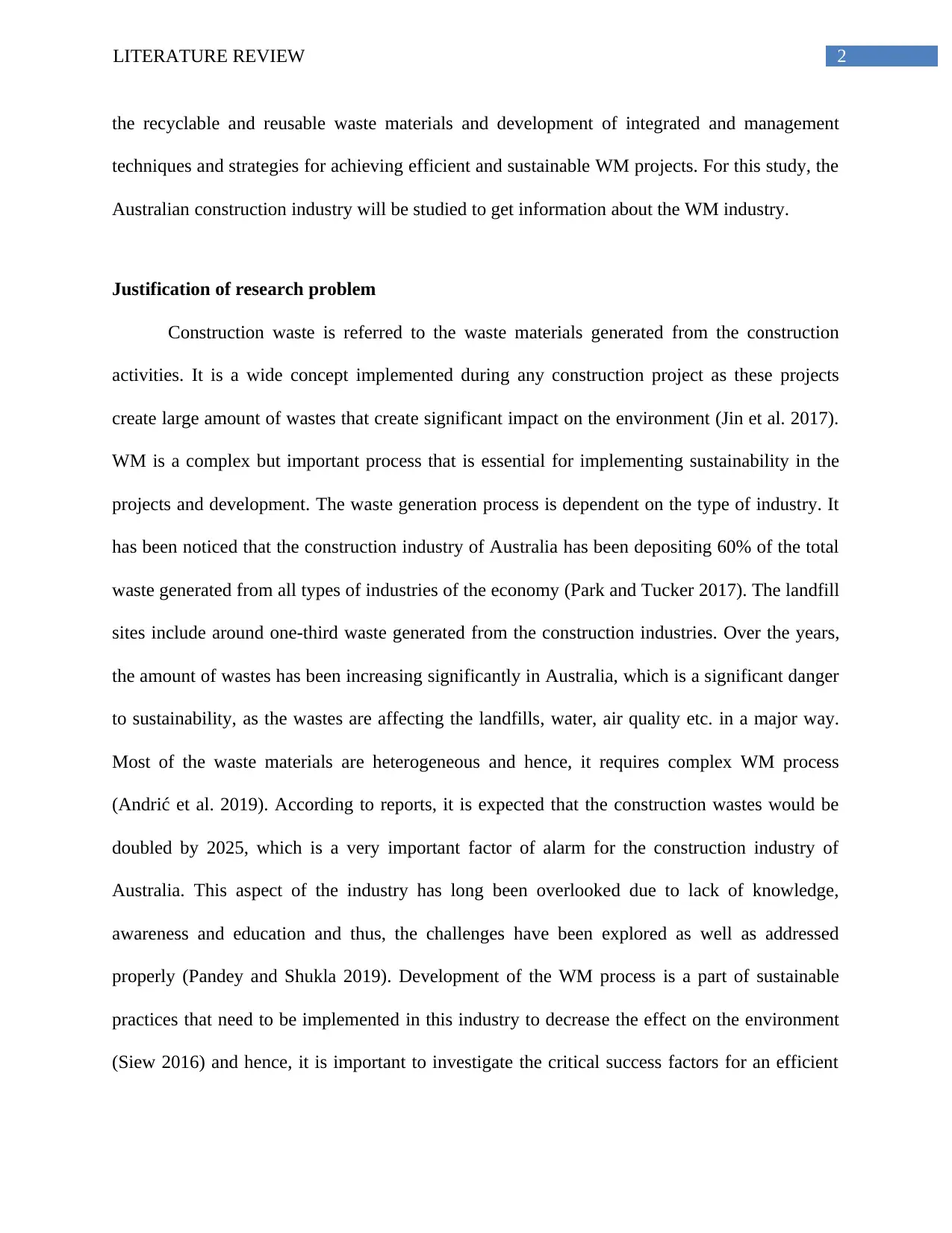
2LITERATURE REVIEW
the recyclable and reusable waste materials and development of integrated and management
techniques and strategies for achieving efficient and sustainable WM projects. For this study, the
Australian construction industry will be studied to get information about the WM industry.
Justification of research problem
Construction waste is referred to the waste materials generated from the construction
activities. It is a wide concept implemented during any construction project as these projects
create large amount of wastes that create significant impact on the environment (Jin et al. 2017).
WM is a complex but important process that is essential for implementing sustainability in the
projects and development. The waste generation process is dependent on the type of industry. It
has been noticed that the construction industry of Australia has been depositing 60% of the total
waste generated from all types of industries of the economy (Park and Tucker 2017). The landfill
sites include around one-third waste generated from the construction industries. Over the years,
the amount of wastes has been increasing significantly in Australia, which is a significant danger
to sustainability, as the wastes are affecting the landfills, water, air quality etc. in a major way.
Most of the waste materials are heterogeneous and hence, it requires complex WM process
(Andrić et al. 2019). According to reports, it is expected that the construction wastes would be
doubled by 2025, which is a very important factor of alarm for the construction industry of
Australia. This aspect of the industry has long been overlooked due to lack of knowledge,
awareness and education and thus, the challenges have been explored as well as addressed
properly (Pandey and Shukla 2019). Development of the WM process is a part of sustainable
practices that need to be implemented in this industry to decrease the effect on the environment
(Siew 2016) and hence, it is important to investigate the critical success factors for an efficient
the recyclable and reusable waste materials and development of integrated and management
techniques and strategies for achieving efficient and sustainable WM projects. For this study, the
Australian construction industry will be studied to get information about the WM industry.
Justification of research problem
Construction waste is referred to the waste materials generated from the construction
activities. It is a wide concept implemented during any construction project as these projects
create large amount of wastes that create significant impact on the environment (Jin et al. 2017).
WM is a complex but important process that is essential for implementing sustainability in the
projects and development. The waste generation process is dependent on the type of industry. It
has been noticed that the construction industry of Australia has been depositing 60% of the total
waste generated from all types of industries of the economy (Park and Tucker 2017). The landfill
sites include around one-third waste generated from the construction industries. Over the years,
the amount of wastes has been increasing significantly in Australia, which is a significant danger
to sustainability, as the wastes are affecting the landfills, water, air quality etc. in a major way.
Most of the waste materials are heterogeneous and hence, it requires complex WM process
(Andrić et al. 2019). According to reports, it is expected that the construction wastes would be
doubled by 2025, which is a very important factor of alarm for the construction industry of
Australia. This aspect of the industry has long been overlooked due to lack of knowledge,
awareness and education and thus, the challenges have been explored as well as addressed
properly (Pandey and Shukla 2019). Development of the WM process is a part of sustainable
practices that need to be implemented in this industry to decrease the effect on the environment
(Siew 2016) and hence, it is important to investigate the critical success factors for an efficient
⊘ This is a preview!⊘
Do you want full access?
Subscribe today to unlock all pages.

Trusted by 1+ million students worldwide
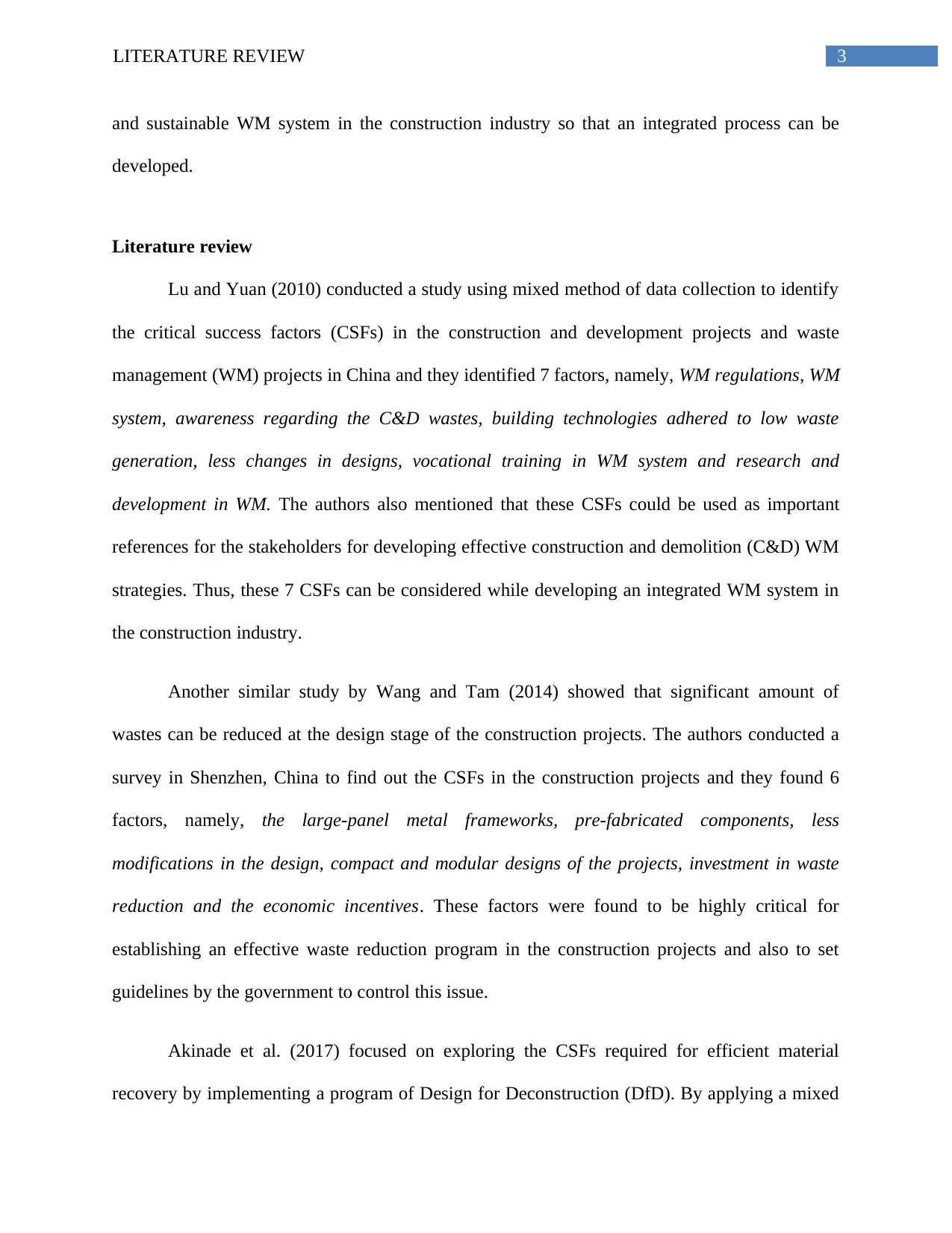
3LITERATURE REVIEW
and sustainable WM system in the construction industry so that an integrated process can be
developed.
Literature review
Lu and Yuan (2010) conducted a study using mixed method of data collection to identify
the critical success factors (CSFs) in the construction and development projects and waste
management (WM) projects in China and they identified 7 factors, namely, WM regulations, WM
system, awareness regarding the C&D wastes, building technologies adhered to low waste
generation, less changes in designs, vocational training in WM system and research and
development in WM. The authors also mentioned that these CSFs could be used as important
references for the stakeholders for developing effective construction and demolition (C&D) WM
strategies. Thus, these 7 CSFs can be considered while developing an integrated WM system in
the construction industry.
Another similar study by Wang and Tam (2014) showed that significant amount of
wastes can be reduced at the design stage of the construction projects. The authors conducted a
survey in Shenzhen, China to find out the CSFs in the construction projects and they found 6
factors, namely, the large-panel metal frameworks, pre-fabricated components, less
modifications in the design, compact and modular designs of the projects, investment in waste
reduction and the economic incentives. These factors were found to be highly critical for
establishing an effective waste reduction program in the construction projects and also to set
guidelines by the government to control this issue.
Akinade et al. (2017) focused on exploring the CSFs required for efficient material
recovery by implementing a program of Design for Deconstruction (DfD). By applying a mixed
and sustainable WM system in the construction industry so that an integrated process can be
developed.
Literature review
Lu and Yuan (2010) conducted a study using mixed method of data collection to identify
the critical success factors (CSFs) in the construction and development projects and waste
management (WM) projects in China and they identified 7 factors, namely, WM regulations, WM
system, awareness regarding the C&D wastes, building technologies adhered to low waste
generation, less changes in designs, vocational training in WM system and research and
development in WM. The authors also mentioned that these CSFs could be used as important
references for the stakeholders for developing effective construction and demolition (C&D) WM
strategies. Thus, these 7 CSFs can be considered while developing an integrated WM system in
the construction industry.
Another similar study by Wang and Tam (2014) showed that significant amount of
wastes can be reduced at the design stage of the construction projects. The authors conducted a
survey in Shenzhen, China to find out the CSFs in the construction projects and they found 6
factors, namely, the large-panel metal frameworks, pre-fabricated components, less
modifications in the design, compact and modular designs of the projects, investment in waste
reduction and the economic incentives. These factors were found to be highly critical for
establishing an effective waste reduction program in the construction projects and also to set
guidelines by the government to control this issue.
Akinade et al. (2017) focused on exploring the CSFs required for efficient material
recovery by implementing a program of Design for Deconstruction (DfD). By applying a mixed
Paraphrase This Document
Need a fresh take? Get an instant paraphrase of this document with our AI Paraphraser
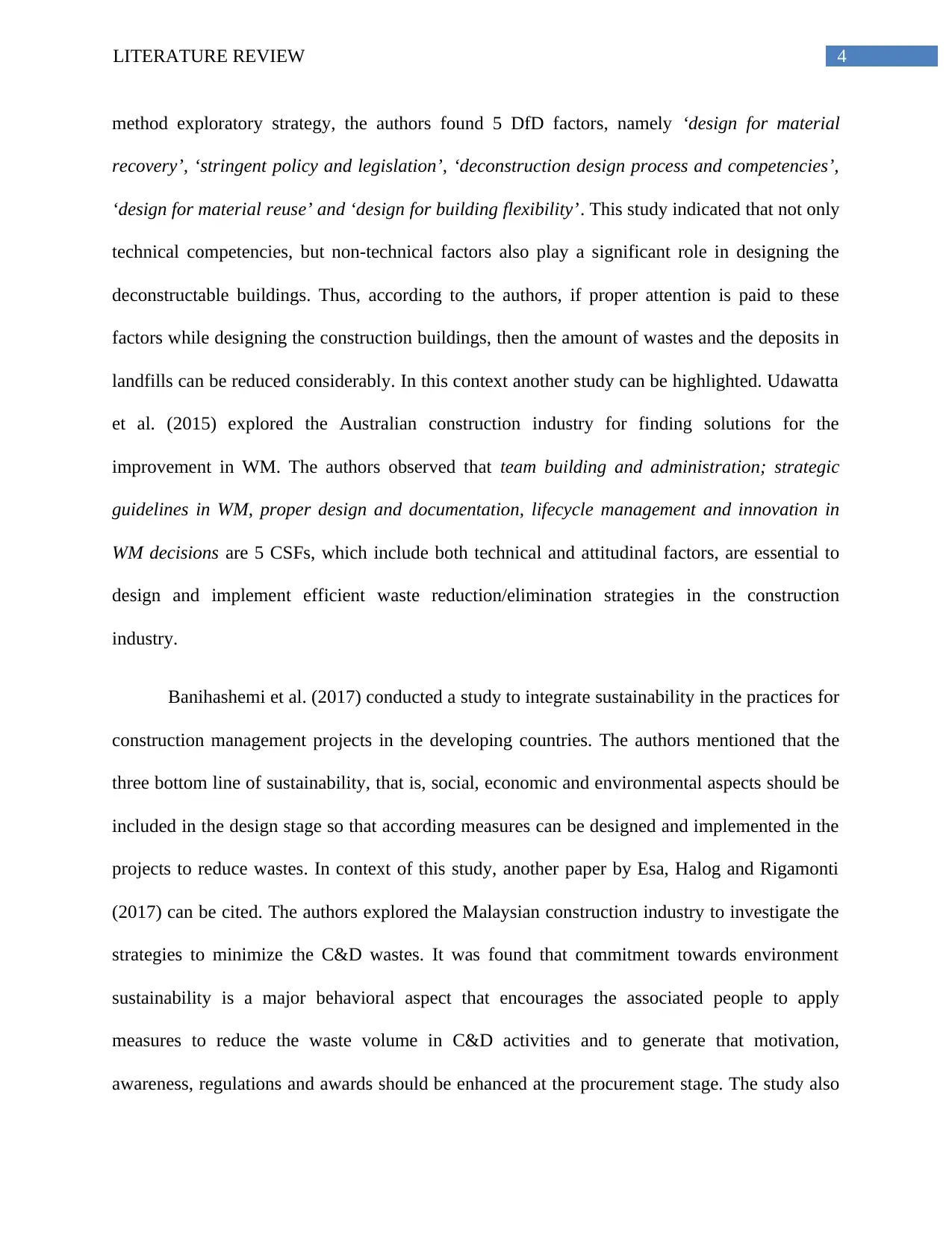
4LITERATURE REVIEW
method exploratory strategy, the authors found 5 DfD factors, namely ‘design for material
recovery’, ‘stringent policy and legislation’, ‘deconstruction design process and competencies’,
‘design for material reuse’ and ‘design for building flexibility’. This study indicated that not only
technical competencies, but non-technical factors also play a significant role in designing the
deconstructable buildings. Thus, according to the authors, if proper attention is paid to these
factors while designing the construction buildings, then the amount of wastes and the deposits in
landfills can be reduced considerably. In this context another study can be highlighted. Udawatta
et al. (2015) explored the Australian construction industry for finding solutions for the
improvement in WM. The authors observed that team building and administration; strategic
guidelines in WM, proper design and documentation, lifecycle management and innovation in
WM decisions are 5 CSFs, which include both technical and attitudinal factors, are essential to
design and implement efficient waste reduction/elimination strategies in the construction
industry.
Banihashemi et al. (2017) conducted a study to integrate sustainability in the practices for
construction management projects in the developing countries. The authors mentioned that the
three bottom line of sustainability, that is, social, economic and environmental aspects should be
included in the design stage so that according measures can be designed and implemented in the
projects to reduce wastes. In context of this study, another paper by Esa, Halog and Rigamonti
(2017) can be cited. The authors explored the Malaysian construction industry to investigate the
strategies to minimize the C&D wastes. It was found that commitment towards environment
sustainability is a major behavioral aspect that encourages the associated people to apply
measures to reduce the waste volume in C&D activities and to generate that motivation,
awareness, regulations and awards should be enhanced at the procurement stage. The study also
method exploratory strategy, the authors found 5 DfD factors, namely ‘design for material
recovery’, ‘stringent policy and legislation’, ‘deconstruction design process and competencies’,
‘design for material reuse’ and ‘design for building flexibility’. This study indicated that not only
technical competencies, but non-technical factors also play a significant role in designing the
deconstructable buildings. Thus, according to the authors, if proper attention is paid to these
factors while designing the construction buildings, then the amount of wastes and the deposits in
landfills can be reduced considerably. In this context another study can be highlighted. Udawatta
et al. (2015) explored the Australian construction industry for finding solutions for the
improvement in WM. The authors observed that team building and administration; strategic
guidelines in WM, proper design and documentation, lifecycle management and innovation in
WM decisions are 5 CSFs, which include both technical and attitudinal factors, are essential to
design and implement efficient waste reduction/elimination strategies in the construction
industry.
Banihashemi et al. (2017) conducted a study to integrate sustainability in the practices for
construction management projects in the developing countries. The authors mentioned that the
three bottom line of sustainability, that is, social, economic and environmental aspects should be
included in the design stage so that according measures can be designed and implemented in the
projects to reduce wastes. In context of this study, another paper by Esa, Halog and Rigamonti
(2017) can be cited. The authors explored the Malaysian construction industry to investigate the
strategies to minimize the C&D wastes. It was found that commitment towards environment
sustainability is a major behavioral aspect that encourages the associated people to apply
measures to reduce the waste volume in C&D activities and to generate that motivation,
awareness, regulations and awards should be enhanced at the procurement stage. The study also
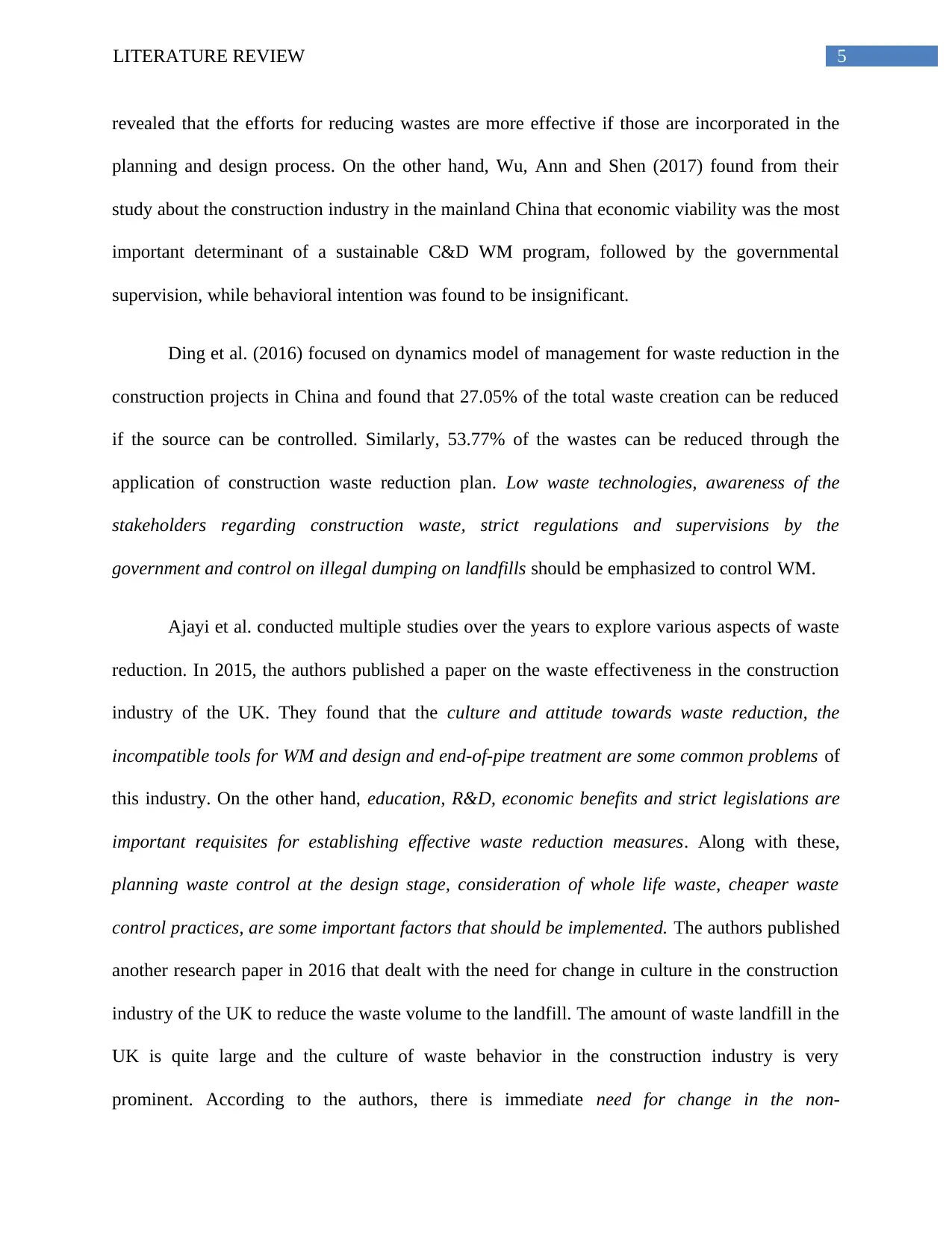
5LITERATURE REVIEW
revealed that the efforts for reducing wastes are more effective if those are incorporated in the
planning and design process. On the other hand, Wu, Ann and Shen (2017) found from their
study about the construction industry in the mainland China that economic viability was the most
important determinant of a sustainable C&D WM program, followed by the governmental
supervision, while behavioral intention was found to be insignificant.
Ding et al. (2016) focused on dynamics model of management for waste reduction in the
construction projects in China and found that 27.05% of the total waste creation can be reduced
if the source can be controlled. Similarly, 53.77% of the wastes can be reduced through the
application of construction waste reduction plan. Low waste technologies, awareness of the
stakeholders regarding construction waste, strict regulations and supervisions by the
government and control on illegal dumping on landfills should be emphasized to control WM.
Ajayi et al. conducted multiple studies over the years to explore various aspects of waste
reduction. In 2015, the authors published a paper on the waste effectiveness in the construction
industry of the UK. They found that the culture and attitude towards waste reduction, the
incompatible tools for WM and design and end-of-pipe treatment are some common problems of
this industry. On the other hand, education, R&D, economic benefits and strict legislations are
important requisites for establishing effective waste reduction measures. Along with these,
planning waste control at the design stage, consideration of whole life waste, cheaper waste
control practices, are some important factors that should be implemented. The authors published
another research paper in 2016 that dealt with the need for change in culture in the construction
industry of the UK to reduce the waste volume to the landfill. The amount of waste landfill in the
UK is quite large and the culture of waste behavior in the construction industry is very
prominent. According to the authors, there is immediate need for change in the non-
revealed that the efforts for reducing wastes are more effective if those are incorporated in the
planning and design process. On the other hand, Wu, Ann and Shen (2017) found from their
study about the construction industry in the mainland China that economic viability was the most
important determinant of a sustainable C&D WM program, followed by the governmental
supervision, while behavioral intention was found to be insignificant.
Ding et al. (2016) focused on dynamics model of management for waste reduction in the
construction projects in China and found that 27.05% of the total waste creation can be reduced
if the source can be controlled. Similarly, 53.77% of the wastes can be reduced through the
application of construction waste reduction plan. Low waste technologies, awareness of the
stakeholders regarding construction waste, strict regulations and supervisions by the
government and control on illegal dumping on landfills should be emphasized to control WM.
Ajayi et al. conducted multiple studies over the years to explore various aspects of waste
reduction. In 2015, the authors published a paper on the waste effectiveness in the construction
industry of the UK. They found that the culture and attitude towards waste reduction, the
incompatible tools for WM and design and end-of-pipe treatment are some common problems of
this industry. On the other hand, education, R&D, economic benefits and strict legislations are
important requisites for establishing effective waste reduction measures. Along with these,
planning waste control at the design stage, consideration of whole life waste, cheaper waste
control practices, are some important factors that should be implemented. The authors published
another research paper in 2016 that dealt with the need for change in culture in the construction
industry of the UK to reduce the waste volume to the landfill. The amount of waste landfill in the
UK is quite large and the culture of waste behavior in the construction industry is very
prominent. According to the authors, there is immediate need for change in the non-
⊘ This is a preview!⊘
Do you want full access?
Subscribe today to unlock all pages.

Trusted by 1+ million students worldwide
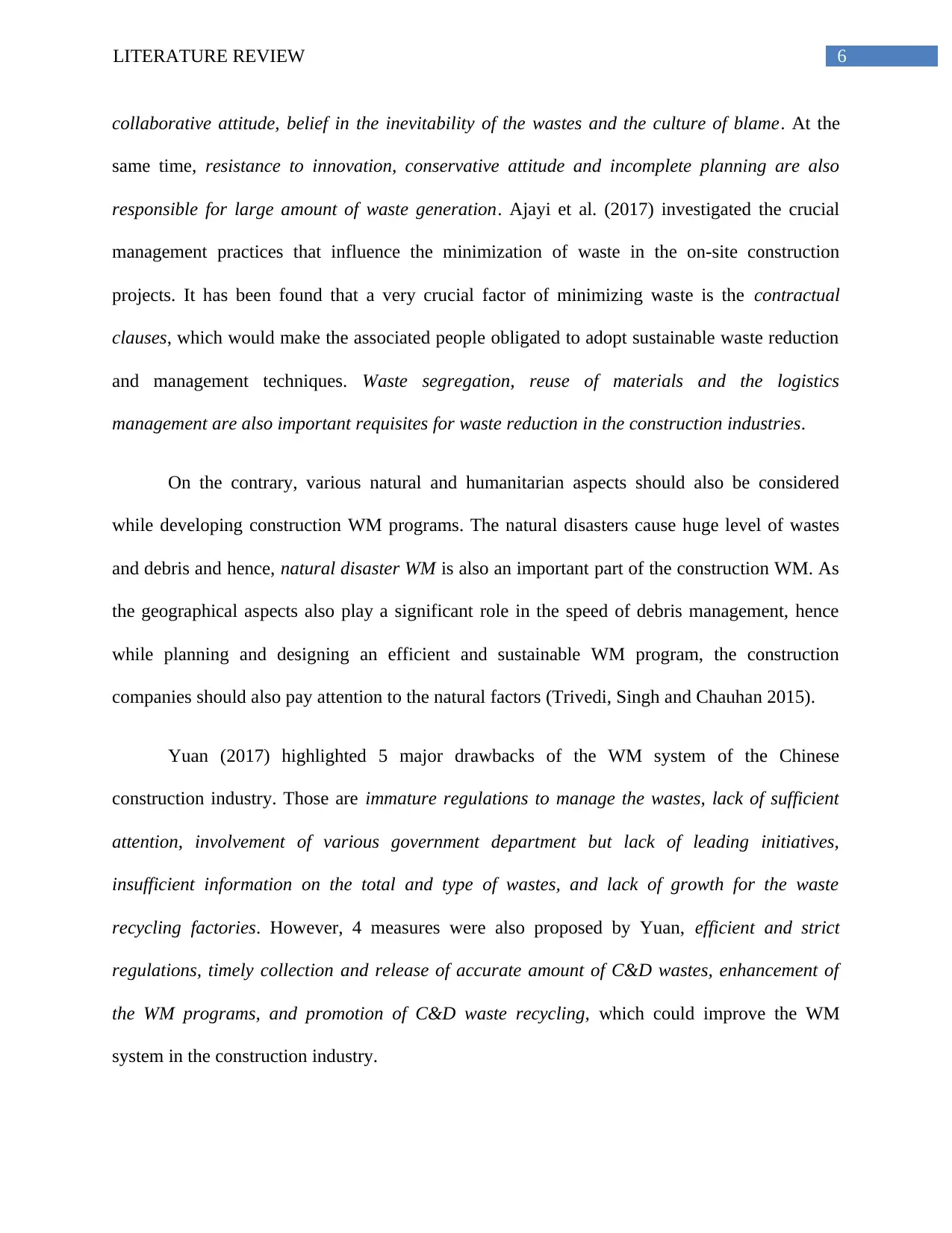
6LITERATURE REVIEW
collaborative attitude, belief in the inevitability of the wastes and the culture of blame. At the
same time, resistance to innovation, conservative attitude and incomplete planning are also
responsible for large amount of waste generation. Ajayi et al. (2017) investigated the crucial
management practices that influence the minimization of waste in the on-site construction
projects. It has been found that a very crucial factor of minimizing waste is the contractual
clauses, which would make the associated people obligated to adopt sustainable waste reduction
and management techniques. Waste segregation, reuse of materials and the logistics
management are also important requisites for waste reduction in the construction industries.
On the contrary, various natural and humanitarian aspects should also be considered
while developing construction WM programs. The natural disasters cause huge level of wastes
and debris and hence, natural disaster WM is also an important part of the construction WM. As
the geographical aspects also play a significant role in the speed of debris management, hence
while planning and designing an efficient and sustainable WM program, the construction
companies should also pay attention to the natural factors (Trivedi, Singh and Chauhan 2015).
Yuan (2017) highlighted 5 major drawbacks of the WM system of the Chinese
construction industry. Those are immature regulations to manage the wastes, lack of sufficient
attention, involvement of various government department but lack of leading initiatives,
insufficient information on the total and type of wastes, and lack of growth for the waste
recycling factories. However, 4 measures were also proposed by Yuan, efficient and strict
regulations, timely collection and release of accurate amount of C&D wastes, enhancement of
the WM programs, and promotion of C&D waste recycling, which could improve the WM
system in the construction industry.
collaborative attitude, belief in the inevitability of the wastes and the culture of blame. At the
same time, resistance to innovation, conservative attitude and incomplete planning are also
responsible for large amount of waste generation. Ajayi et al. (2017) investigated the crucial
management practices that influence the minimization of waste in the on-site construction
projects. It has been found that a very crucial factor of minimizing waste is the contractual
clauses, which would make the associated people obligated to adopt sustainable waste reduction
and management techniques. Waste segregation, reuse of materials and the logistics
management are also important requisites for waste reduction in the construction industries.
On the contrary, various natural and humanitarian aspects should also be considered
while developing construction WM programs. The natural disasters cause huge level of wastes
and debris and hence, natural disaster WM is also an important part of the construction WM. As
the geographical aspects also play a significant role in the speed of debris management, hence
while planning and designing an efficient and sustainable WM program, the construction
companies should also pay attention to the natural factors (Trivedi, Singh and Chauhan 2015).
Yuan (2017) highlighted 5 major drawbacks of the WM system of the Chinese
construction industry. Those are immature regulations to manage the wastes, lack of sufficient
attention, involvement of various government department but lack of leading initiatives,
insufficient information on the total and type of wastes, and lack of growth for the waste
recycling factories. However, 4 measures were also proposed by Yuan, efficient and strict
regulations, timely collection and release of accurate amount of C&D wastes, enhancement of
the WM programs, and promotion of C&D waste recycling, which could improve the WM
system in the construction industry.
Paraphrase This Document
Need a fresh take? Get an instant paraphrase of this document with our AI Paraphraser
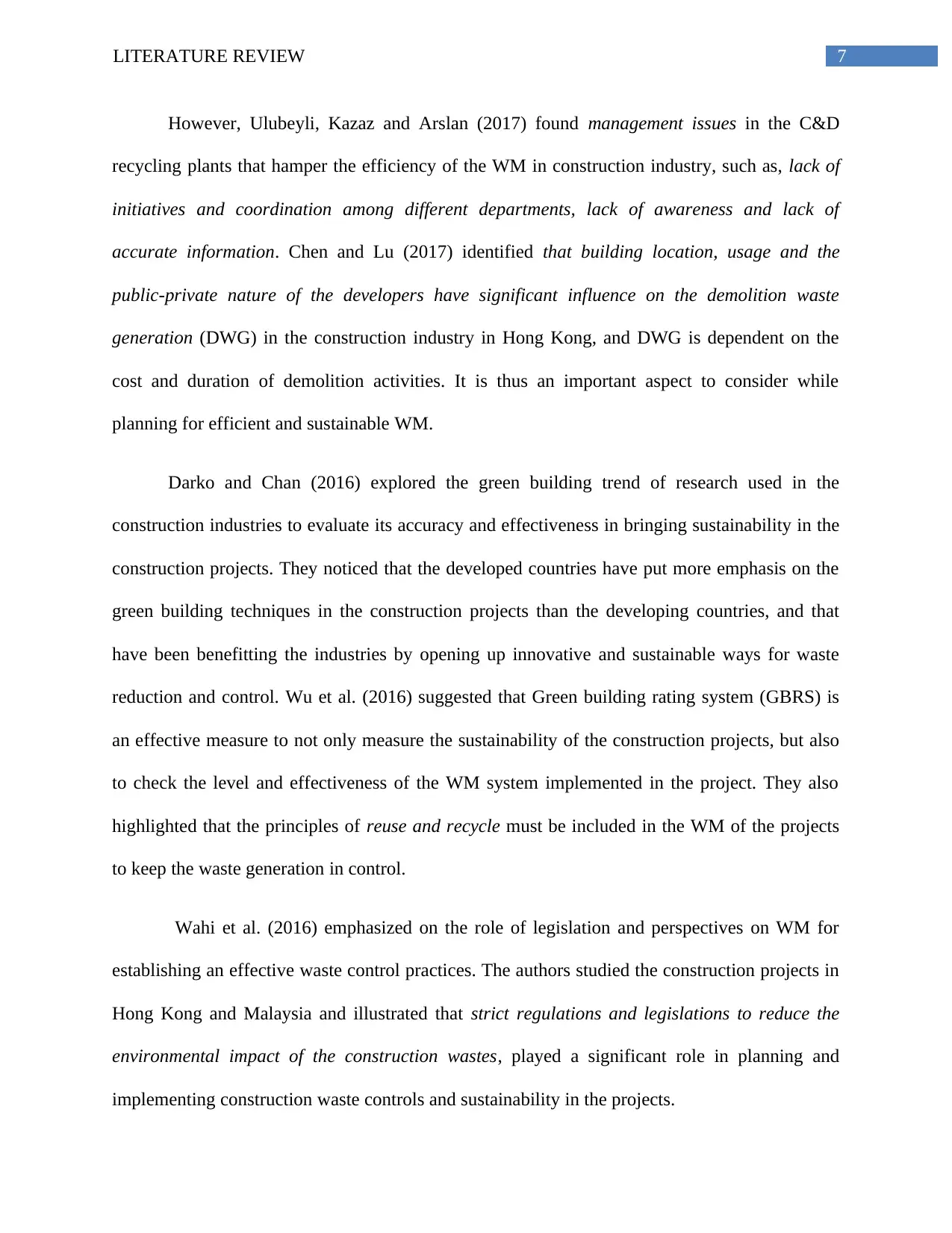
7LITERATURE REVIEW
However, Ulubeyli, Kazaz and Arslan (2017) found management issues in the C&D
recycling plants that hamper the efficiency of the WM in construction industry, such as, lack of
initiatives and coordination among different departments, lack of awareness and lack of
accurate information. Chen and Lu (2017) identified that building location, usage and the
public-private nature of the developers have significant influence on the demolition waste
generation (DWG) in the construction industry in Hong Kong, and DWG is dependent on the
cost and duration of demolition activities. It is thus an important aspect to consider while
planning for efficient and sustainable WM.
Darko and Chan (2016) explored the green building trend of research used in the
construction industries to evaluate its accuracy and effectiveness in bringing sustainability in the
construction projects. They noticed that the developed countries have put more emphasis on the
green building techniques in the construction projects than the developing countries, and that
have been benefitting the industries by opening up innovative and sustainable ways for waste
reduction and control. Wu et al. (2016) suggested that Green building rating system (GBRS) is
an effective measure to not only measure the sustainability of the construction projects, but also
to check the level and effectiveness of the WM system implemented in the project. They also
highlighted that the principles of reuse and recycle must be included in the WM of the projects
to keep the waste generation in control.
Wahi et al. (2016) emphasized on the role of legislation and perspectives on WM for
establishing an effective waste control practices. The authors studied the construction projects in
Hong Kong and Malaysia and illustrated that strict regulations and legislations to reduce the
environmental impact of the construction wastes, played a significant role in planning and
implementing construction waste controls and sustainability in the projects.
However, Ulubeyli, Kazaz and Arslan (2017) found management issues in the C&D
recycling plants that hamper the efficiency of the WM in construction industry, such as, lack of
initiatives and coordination among different departments, lack of awareness and lack of
accurate information. Chen and Lu (2017) identified that building location, usage and the
public-private nature of the developers have significant influence on the demolition waste
generation (DWG) in the construction industry in Hong Kong, and DWG is dependent on the
cost and duration of demolition activities. It is thus an important aspect to consider while
planning for efficient and sustainable WM.
Darko and Chan (2016) explored the green building trend of research used in the
construction industries to evaluate its accuracy and effectiveness in bringing sustainability in the
construction projects. They noticed that the developed countries have put more emphasis on the
green building techniques in the construction projects than the developing countries, and that
have been benefitting the industries by opening up innovative and sustainable ways for waste
reduction and control. Wu et al. (2016) suggested that Green building rating system (GBRS) is
an effective measure to not only measure the sustainability of the construction projects, but also
to check the level and effectiveness of the WM system implemented in the project. They also
highlighted that the principles of reuse and recycle must be included in the WM of the projects
to keep the waste generation in control.
Wahi et al. (2016) emphasized on the role of legislation and perspectives on WM for
establishing an effective waste control practices. The authors studied the construction projects in
Hong Kong and Malaysia and illustrated that strict regulations and legislations to reduce the
environmental impact of the construction wastes, played a significant role in planning and
implementing construction waste controls and sustainability in the projects.
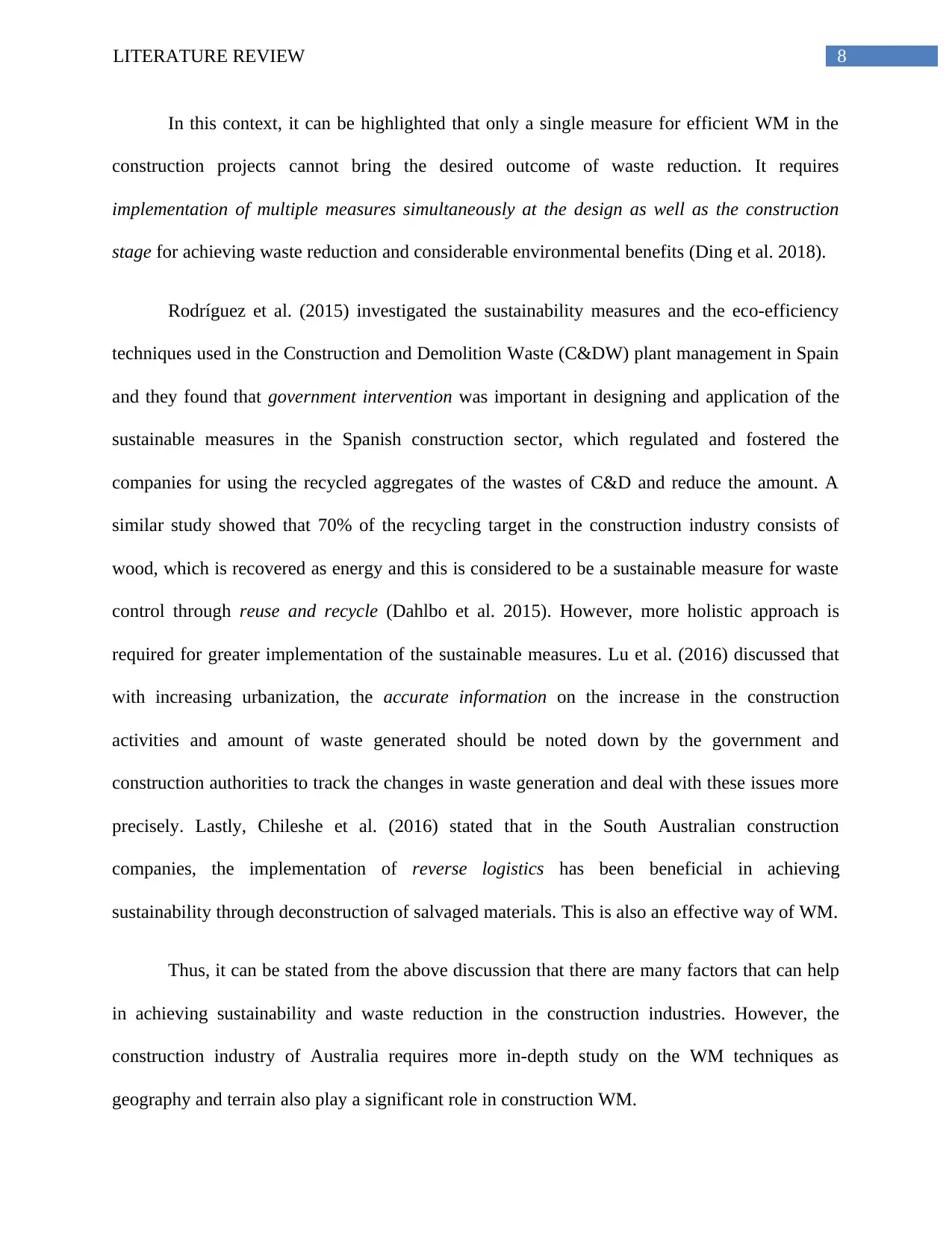
8LITERATURE REVIEW
In this context, it can be highlighted that only a single measure for efficient WM in the
construction projects cannot bring the desired outcome of waste reduction. It requires
implementation of multiple measures simultaneously at the design as well as the construction
stage for achieving waste reduction and considerable environmental benefits (Ding et al. 2018).
Rodríguez et al. (2015) investigated the sustainability measures and the eco-efficiency
techniques used in the Construction and Demolition Waste (C&DW) plant management in Spain
and they found that government intervention was important in designing and application of the
sustainable measures in the Spanish construction sector, which regulated and fostered the
companies for using the recycled aggregates of the wastes of C&D and reduce the amount. A
similar study showed that 70% of the recycling target in the construction industry consists of
wood, which is recovered as energy and this is considered to be a sustainable measure for waste
control through reuse and recycle (Dahlbo et al. 2015). However, more holistic approach is
required for greater implementation of the sustainable measures. Lu et al. (2016) discussed that
with increasing urbanization, the accurate information on the increase in the construction
activities and amount of waste generated should be noted down by the government and
construction authorities to track the changes in waste generation and deal with these issues more
precisely. Lastly, Chileshe et al. (2016) stated that in the South Australian construction
companies, the implementation of reverse logistics has been beneficial in achieving
sustainability through deconstruction of salvaged materials. This is also an effective way of WM.
Thus, it can be stated from the above discussion that there are many factors that can help
in achieving sustainability and waste reduction in the construction industries. However, the
construction industry of Australia requires more in-depth study on the WM techniques as
geography and terrain also play a significant role in construction WM.
In this context, it can be highlighted that only a single measure for efficient WM in the
construction projects cannot bring the desired outcome of waste reduction. It requires
implementation of multiple measures simultaneously at the design as well as the construction
stage for achieving waste reduction and considerable environmental benefits (Ding et al. 2018).
Rodríguez et al. (2015) investigated the sustainability measures and the eco-efficiency
techniques used in the Construction and Demolition Waste (C&DW) plant management in Spain
and they found that government intervention was important in designing and application of the
sustainable measures in the Spanish construction sector, which regulated and fostered the
companies for using the recycled aggregates of the wastes of C&D and reduce the amount. A
similar study showed that 70% of the recycling target in the construction industry consists of
wood, which is recovered as energy and this is considered to be a sustainable measure for waste
control through reuse and recycle (Dahlbo et al. 2015). However, more holistic approach is
required for greater implementation of the sustainable measures. Lu et al. (2016) discussed that
with increasing urbanization, the accurate information on the increase in the construction
activities and amount of waste generated should be noted down by the government and
construction authorities to track the changes in waste generation and deal with these issues more
precisely. Lastly, Chileshe et al. (2016) stated that in the South Australian construction
companies, the implementation of reverse logistics has been beneficial in achieving
sustainability through deconstruction of salvaged materials. This is also an effective way of WM.
Thus, it can be stated from the above discussion that there are many factors that can help
in achieving sustainability and waste reduction in the construction industries. However, the
construction industry of Australia requires more in-depth study on the WM techniques as
geography and terrain also play a significant role in construction WM.
⊘ This is a preview!⊘
Do you want full access?
Subscribe today to unlock all pages.

Trusted by 1+ million students worldwide
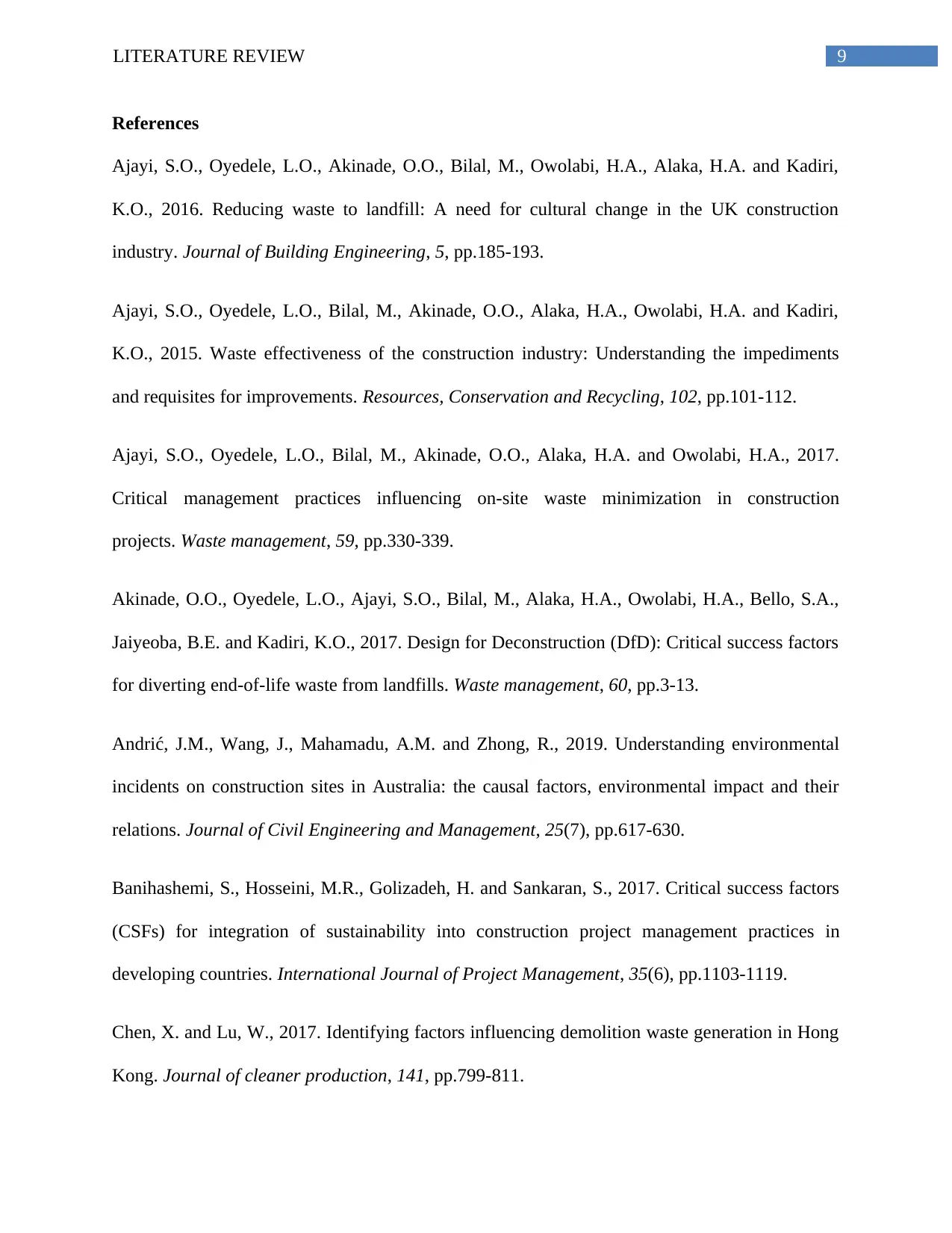
9LITERATURE REVIEW
References
Ajayi, S.O., Oyedele, L.O., Akinade, O.O., Bilal, M., Owolabi, H.A., Alaka, H.A. and Kadiri,
K.O., 2016. Reducing waste to landfill: A need for cultural change in the UK construction
industry. Journal of Building Engineering, 5, pp.185-193.
Ajayi, S.O., Oyedele, L.O., Bilal, M., Akinade, O.O., Alaka, H.A., Owolabi, H.A. and Kadiri,
K.O., 2015. Waste effectiveness of the construction industry: Understanding the impediments
and requisites for improvements. Resources, Conservation and Recycling, 102, pp.101-112.
Ajayi, S.O., Oyedele, L.O., Bilal, M., Akinade, O.O., Alaka, H.A. and Owolabi, H.A., 2017.
Critical management practices influencing on-site waste minimization in construction
projects. Waste management, 59, pp.330-339.
Akinade, O.O., Oyedele, L.O., Ajayi, S.O., Bilal, M., Alaka, H.A., Owolabi, H.A., Bello, S.A.,
Jaiyeoba, B.E. and Kadiri, K.O., 2017. Design for Deconstruction (DfD): Critical success factors
for diverting end-of-life waste from landfills. Waste management, 60, pp.3-13.
Andrić, J.M., Wang, J., Mahamadu, A.M. and Zhong, R., 2019. Understanding environmental
incidents on construction sites in Australia: the causal factors, environmental impact and their
relations. Journal of Civil Engineering and Management, 25(7), pp.617-630.
Banihashemi, S., Hosseini, M.R., Golizadeh, H. and Sankaran, S., 2017. Critical success factors
(CSFs) for integration of sustainability into construction project management practices in
developing countries. International Journal of Project Management, 35(6), pp.1103-1119.
Chen, X. and Lu, W., 2017. Identifying factors influencing demolition waste generation in Hong
Kong. Journal of cleaner production, 141, pp.799-811.
References
Ajayi, S.O., Oyedele, L.O., Akinade, O.O., Bilal, M., Owolabi, H.A., Alaka, H.A. and Kadiri,
K.O., 2016. Reducing waste to landfill: A need for cultural change in the UK construction
industry. Journal of Building Engineering, 5, pp.185-193.
Ajayi, S.O., Oyedele, L.O., Bilal, M., Akinade, O.O., Alaka, H.A., Owolabi, H.A. and Kadiri,
K.O., 2015. Waste effectiveness of the construction industry: Understanding the impediments
and requisites for improvements. Resources, Conservation and Recycling, 102, pp.101-112.
Ajayi, S.O., Oyedele, L.O., Bilal, M., Akinade, O.O., Alaka, H.A. and Owolabi, H.A., 2017.
Critical management practices influencing on-site waste minimization in construction
projects. Waste management, 59, pp.330-339.
Akinade, O.O., Oyedele, L.O., Ajayi, S.O., Bilal, M., Alaka, H.A., Owolabi, H.A., Bello, S.A.,
Jaiyeoba, B.E. and Kadiri, K.O., 2017. Design for Deconstruction (DfD): Critical success factors
for diverting end-of-life waste from landfills. Waste management, 60, pp.3-13.
Andrić, J.M., Wang, J., Mahamadu, A.M. and Zhong, R., 2019. Understanding environmental
incidents on construction sites in Australia: the causal factors, environmental impact and their
relations. Journal of Civil Engineering and Management, 25(7), pp.617-630.
Banihashemi, S., Hosseini, M.R., Golizadeh, H. and Sankaran, S., 2017. Critical success factors
(CSFs) for integration of sustainability into construction project management practices in
developing countries. International Journal of Project Management, 35(6), pp.1103-1119.
Chen, X. and Lu, W., 2017. Identifying factors influencing demolition waste generation in Hong
Kong. Journal of cleaner production, 141, pp.799-811.
Paraphrase This Document
Need a fresh take? Get an instant paraphrase of this document with our AI Paraphraser
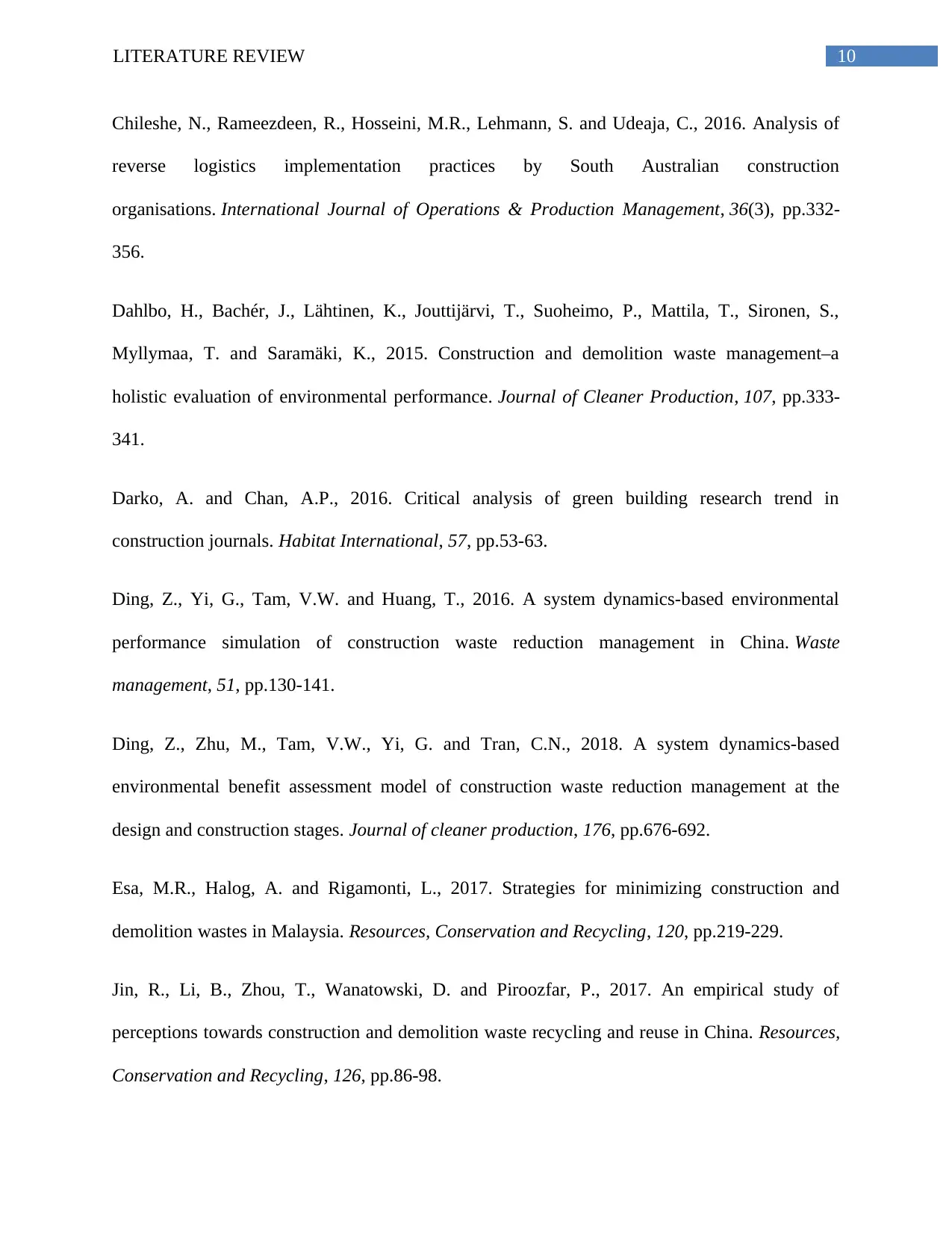
10LITERATURE REVIEW
Chileshe, N., Rameezdeen, R., Hosseini, M.R., Lehmann, S. and Udeaja, C., 2016. Analysis of
reverse logistics implementation practices by South Australian construction
organisations. International Journal of Operations & Production Management, 36(3), pp.332-
356.
Dahlbo, H., Bachér, J., Lähtinen, K., Jouttijärvi, T., Suoheimo, P., Mattila, T., Sironen, S.,
Myllymaa, T. and Saramäki, K., 2015. Construction and demolition waste management–a
holistic evaluation of environmental performance. Journal of Cleaner Production, 107, pp.333-
341.
Darko, A. and Chan, A.P., 2016. Critical analysis of green building research trend in
construction journals. Habitat International, 57, pp.53-63.
Ding, Z., Yi, G., Tam, V.W. and Huang, T., 2016. A system dynamics-based environmental
performance simulation of construction waste reduction management in China. Waste
management, 51, pp.130-141.
Ding, Z., Zhu, M., Tam, V.W., Yi, G. and Tran, C.N., 2018. A system dynamics-based
environmental benefit assessment model of construction waste reduction management at the
design and construction stages. Journal of cleaner production, 176, pp.676-692.
Esa, M.R., Halog, A. and Rigamonti, L., 2017. Strategies for minimizing construction and
demolition wastes in Malaysia. Resources, Conservation and Recycling, 120, pp.219-229.
Jin, R., Li, B., Zhou, T., Wanatowski, D. and Piroozfar, P., 2017. An empirical study of
perceptions towards construction and demolition waste recycling and reuse in China. Resources,
Conservation and Recycling, 126, pp.86-98.
Chileshe, N., Rameezdeen, R., Hosseini, M.R., Lehmann, S. and Udeaja, C., 2016. Analysis of
reverse logistics implementation practices by South Australian construction
organisations. International Journal of Operations & Production Management, 36(3), pp.332-
356.
Dahlbo, H., Bachér, J., Lähtinen, K., Jouttijärvi, T., Suoheimo, P., Mattila, T., Sironen, S.,
Myllymaa, T. and Saramäki, K., 2015. Construction and demolition waste management–a
holistic evaluation of environmental performance. Journal of Cleaner Production, 107, pp.333-
341.
Darko, A. and Chan, A.P., 2016. Critical analysis of green building research trend in
construction journals. Habitat International, 57, pp.53-63.
Ding, Z., Yi, G., Tam, V.W. and Huang, T., 2016. A system dynamics-based environmental
performance simulation of construction waste reduction management in China. Waste
management, 51, pp.130-141.
Ding, Z., Zhu, M., Tam, V.W., Yi, G. and Tran, C.N., 2018. A system dynamics-based
environmental benefit assessment model of construction waste reduction management at the
design and construction stages. Journal of cleaner production, 176, pp.676-692.
Esa, M.R., Halog, A. and Rigamonti, L., 2017. Strategies for minimizing construction and
demolition wastes in Malaysia. Resources, Conservation and Recycling, 120, pp.219-229.
Jin, R., Li, B., Zhou, T., Wanatowski, D. and Piroozfar, P., 2017. An empirical study of
perceptions towards construction and demolition waste recycling and reuse in China. Resources,
Conservation and Recycling, 126, pp.86-98.
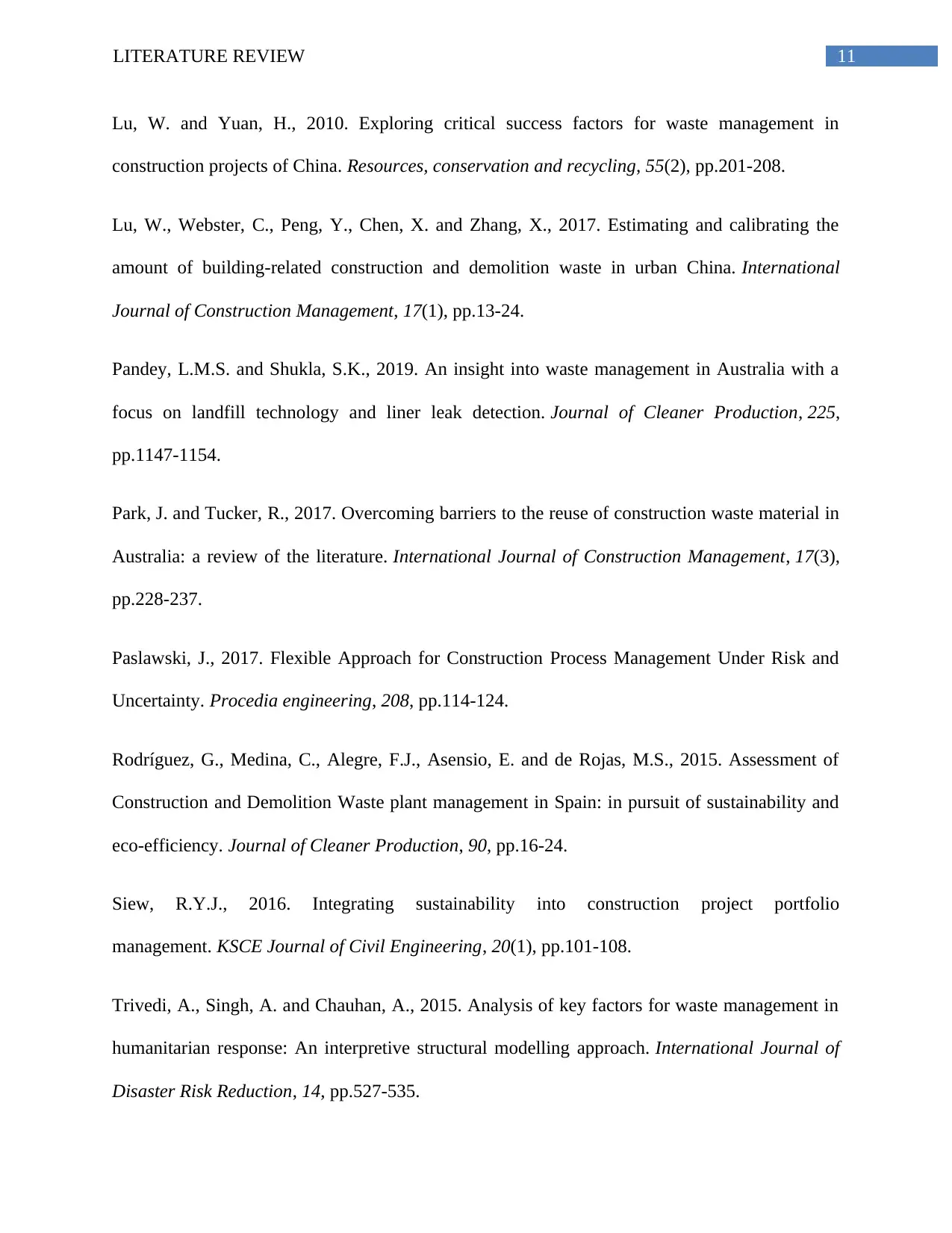
11LITERATURE REVIEW
Lu, W. and Yuan, H., 2010. Exploring critical success factors for waste management in
construction projects of China. Resources, conservation and recycling, 55(2), pp.201-208.
Lu, W., Webster, C., Peng, Y., Chen, X. and Zhang, X., 2017. Estimating and calibrating the
amount of building-related construction and demolition waste in urban China. International
Journal of Construction Management, 17(1), pp.13-24.
Pandey, L.M.S. and Shukla, S.K., 2019. An insight into waste management in Australia with a
focus on landfill technology and liner leak detection. Journal of Cleaner Production, 225,
pp.1147-1154.
Park, J. and Tucker, R., 2017. Overcoming barriers to the reuse of construction waste material in
Australia: a review of the literature. International Journal of Construction Management, 17(3),
pp.228-237.
Paslawski, J., 2017. Flexible Approach for Construction Process Management Under Risk and
Uncertainty. Procedia engineering, 208, pp.114-124.
Rodríguez, G., Medina, C., Alegre, F.J., Asensio, E. and de Rojas, M.S., 2015. Assessment of
Construction and Demolition Waste plant management in Spain: in pursuit of sustainability and
eco-efficiency. Journal of Cleaner Production, 90, pp.16-24.
Siew, R.Y.J., 2016. Integrating sustainability into construction project portfolio
management. KSCE Journal of Civil Engineering, 20(1), pp.101-108.
Trivedi, A., Singh, A. and Chauhan, A., 2015. Analysis of key factors for waste management in
humanitarian response: An interpretive structural modelling approach. International Journal of
Disaster Risk Reduction, 14, pp.527-535.
Lu, W. and Yuan, H., 2010. Exploring critical success factors for waste management in
construction projects of China. Resources, conservation and recycling, 55(2), pp.201-208.
Lu, W., Webster, C., Peng, Y., Chen, X. and Zhang, X., 2017. Estimating and calibrating the
amount of building-related construction and demolition waste in urban China. International
Journal of Construction Management, 17(1), pp.13-24.
Pandey, L.M.S. and Shukla, S.K., 2019. An insight into waste management in Australia with a
focus on landfill technology and liner leak detection. Journal of Cleaner Production, 225,
pp.1147-1154.
Park, J. and Tucker, R., 2017. Overcoming barriers to the reuse of construction waste material in
Australia: a review of the literature. International Journal of Construction Management, 17(3),
pp.228-237.
Paslawski, J., 2017. Flexible Approach for Construction Process Management Under Risk and
Uncertainty. Procedia engineering, 208, pp.114-124.
Rodríguez, G., Medina, C., Alegre, F.J., Asensio, E. and de Rojas, M.S., 2015. Assessment of
Construction and Demolition Waste plant management in Spain: in pursuit of sustainability and
eco-efficiency. Journal of Cleaner Production, 90, pp.16-24.
Siew, R.Y.J., 2016. Integrating sustainability into construction project portfolio
management. KSCE Journal of Civil Engineering, 20(1), pp.101-108.
Trivedi, A., Singh, A. and Chauhan, A., 2015. Analysis of key factors for waste management in
humanitarian response: An interpretive structural modelling approach. International Journal of
Disaster Risk Reduction, 14, pp.527-535.
⊘ This is a preview!⊘
Do you want full access?
Subscribe today to unlock all pages.

Trusted by 1+ million students worldwide
1 out of 14
Related Documents
Your All-in-One AI-Powered Toolkit for Academic Success.
+13062052269
info@desklib.com
Available 24*7 on WhatsApp / Email
![[object Object]](/_next/static/media/star-bottom.7253800d.svg)
Unlock your academic potential
Copyright © 2020–2025 A2Z Services. All Rights Reserved. Developed and managed by ZUCOL.




